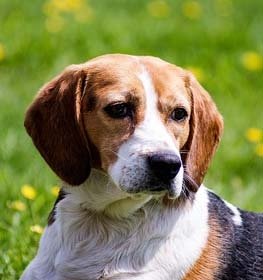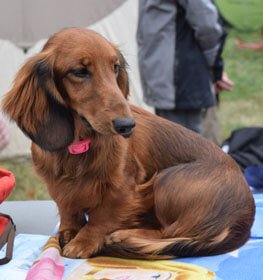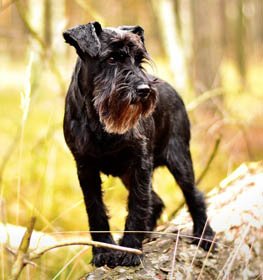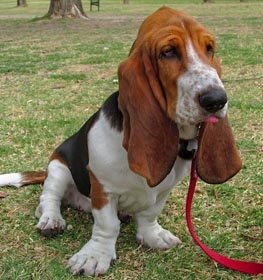Poitevin Information & Dog Breed Facts
Collection of all the general dog breed info about Poitevin so you can get to know the breed more.
| Group | Hunting Dogs |
|---|---|
| Popularity Rank | 193 |
| Reviews | 0 |
| User Ratings | |
|
Compare the Poitevin With Other Dogs
Select at least one dog breed to make the comparsion. | |
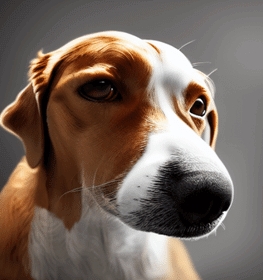 | |
| Origin | |
|
Common Names & Aliases
What other names is a Poitevin known by? Discover all traditional, regional and informal names used for this breed. | Chien du Haut-PoitouHaut-Poitou |
|---|---|
|
Breed Classification
What type of dog breed is a Poitevin? Learn about its genetic classification and breeding category. | Purebred |
|
Size Classification
What size category is a Poitevin? Learn how big the Poitevin breed typically grows. | Large |
|---|---|
|
Weight Statistics
How much does a Poitevin weigh? Discover typical weight ranges for adult males and females of the Poitevin breed. | Male: 65-75 pounds (29-34 kg), Female: 60-70 pounds (27-32 kg) |
|
Average Weight
What is the average weight of a Poitevin? | Male: 70 pounds (31.5 kg), Female: 65 pounds (29.5 kg) |
|
Height
How tall is the Poitevin? Poitevin height: | Male: 24-28 inches (61–71 cm), Female: 23-27 inches (58–69 cm) |
|
Average Height
What is the average height of a Poitevin? | Male: 26 inches (66 cm), Female: 25 inches (63.5 cm) |
|
Price Range
How much does a Poitevin puppy cost? Find current market prices and factors affecting Poitevin costs. | Unknown Unfortunately, we couldn't find the price of the Poitevin. If you have a Poitevin for sale, please advertise it on a reliable website to make sure the Poitevin gets to a happy place. |
|---|---|
|
Availability
How easy is it to get a Poitevin? How many Poitevin are there in the world? | Frequent: The Poitevin is easier than average to get. Maybe there is some risk of overbreeding, as it is a popular breed. Due to its popularity, inbreeding may occur. A new study shows that inbreeding contributes to the incidence of disease and health problems. So be careful and seek the help of an experienced person or a professional, in making your decision. |
|
Intelligence Rating
How intelligent is a Poitevin? Discover the Poitevin's intelligence ranking and learning capabilities. | Smart: The Poitevin dogs have great intelligence. They understand and memorize new commands in 15-25 repetitions.
The Poitevin is among the smartest dogs in the intelligence ranking. |
|---|---|
|
Training Difficulty
How easy is it to train a Poitevin? Learn about the Poitevin's trainability and response to training methods. | Poitevin dogs are quite easy to train. Sometimes they can be challenging, but if you're consistent in teaching new commands they will obey for sure. |
|
Watchdog Rating
How good is a Poitevin as a watchdog? Learn about the Poitevin's alertness and guarding instincts. | Poitevin dogs are one of the best watchdogs. Their main job is to observe and they're very consistent in their effort. The best vocal cords and sense of hearing belong to them. Usually, they're very territorial and protective about their property, so the Poitevin dogs will alert you if they sense something different. |
|
Territorial Protection
Is a Poitevin protective of its territory? Learn about the Poitevin's guarding instincts and behavior. | Poitevin dogs are average defenders. Some dogs are very protective of their territory, while others easily let a stranger to trespass. This breed is not sure to defend its territory in every situation. |
|
Personality Traits
What personality does a Poitevin have? Learn about characteristic Poitevin temperament and behavior traits. | PlayfulAloofLoyalBraveObstinateWillfulUnaffectionate |
|---|---|
|
Sensitivity Level
How sensitive are they? Poitevin sensitivity: | Poitevin dogs have an average emotional level and are not the most sensitive dog breed. Sometimes it's okay to change the daily routine, have guests and listen to loud music.
Some dogs handle moderate punishment very well, while others crumble apart at a dirty look. This breed is not affected emotionally by moderate punishment. |
|
Affection Level
How affectionate are they? Is a Poitevin a good family dog? | Below Average: Poitevin dogs don't bond too closely to their owners. This breed is often aloof and distant. |
|
Social Needs
How much social interaction does the Chien du Haut-Poitou need? Poitevin social needs: | Poitevin dogs need a lot of social interaction. They desire to always be with someone or around people. This breed hates being left alone. |
|
Impulse to Wander or Roam
How likely is the Poitevin to run away? Does this breed explore or wander a lot? Does Poitevin roam? | Poitevin dogs have high wanderlust potential, which means that this breed has a strong desire for exploring the world. Safer to walk them on a leash unless you teach them how to get back to you on command. This breed is also able to cause damage to your fence. |
|
Prey Drive
Do this canine have a strong prey drive? Does Poitevin have high prey drive? | Poitevin dogs have a high impulse to chase and catch something. Cats or any other small animals are in danger. It's a natural instinct, doesn't necessarily mean that Poitevin dogs are aggressive. Better to keep this breed on a leash. |
|
Barking Frequency
Does a Poitevin bark a lot? Learn about typical Poitevin vocalization patterns and triggers. | Average to High: The Poitevin is a vocal breed. Not the best choice if you prefer a quiet breed. They often bark loudly and howl sometimes. They can change their barks depending on their emotional level and what they're trying to say. Different barks could mean the same and the same barks could have different meanings.
Top reasons for barking: protection, alarm, fear, boredom, attention-seeking, greeting, separation anxiety, compulsive barking. |
|---|---|
|
Playful Nature
How playful is a Poitevin? Understand the typical play drive and energy level of the Poitevin breed. | The Poitevin is a highly playful breed. Excited barking and sometimes nipping will alert you to play. |
|
Apartment Adaptability
Can a Poitevin live in an apartment? Learn about the Poitevin's suitability for apartment living. | Not an apartment-friendly dog the Poitevin breed. If you don't have a garden, think carefully about your decision, keeping Poitevin indoors can cause a lot of problems. |
|
Lifestyle Adaptability
How adaptable is a Poitevin to lifestyle changes? Learn about the Poitevin's flexibility to new situations. | Average: Poitevin dogs adapt to lifestyle changes and different living environments quite okay usually. |
|---|---|
|
Alone Time Tolerance
Can a Poitevin be left alone? Learn about the Poitevin's tolerance to solitude. | Poitevin dogs tend to have separation anxiety when their owners left them alone at home because they bond very closely with them. |
|
Bite Risk Assessment
What is a Poitevin biting potential? Learn about the Poitevin's bite risk factors. | Low 🔽 The Poitevin has a low chance of biting somebody. Top reasons for dog bite: protection, pain, excitement, herding instinct, being provoked. (Data based on the available online bite statistics.) |
|---|---|
|
Mouthing Tendency
Is a Poitevin mouthy? Learn about the Poitevin's tendency to use mouth during play. | Poitevin dogs have an average tendency to nip, chew, playbite, or herd people. It's a common habit during puppyhood, not aggressive behavior. These "bites" don't hurt, but Poitevin dogs need to be taught a good attitude. |
|
Bite Strength Rating
How strong is a Poitevin bite? Learn about the Poitevin's bite force measured in PSI. | Between 200 and 400 PSI ⏺ Poitevin bite force: Ordinary. Bite force Poitevin measurements typically fall within the range of 200 to 400 PSI. The bite force of a Poitevin is considered ordinary when compared to other dog breeds, but it is still quite powerful. This Poitevin bite force PSI can cause bite wounds. Poitevin bite PSI is not something that should be feared if the dog is well-trained and managed. To avoid any issues, it's essential to learn how to train a Poitevin puppy not to bite from an early age.
The Poitevin, and many others, have a fearsome presence because they have significant jaw strength, so it is important not to anger the dog and have it around strangers until it is fully trained. However, they are usually quite calm and good companions, they work well in families and are easy to care for. In conclusion, while the Poitevin bite force is certainly an interesting aspect of the breed, it is important not to let it overshadow the many other reasons why these dogs are so loved and respected. With proper training and socialization, a Poitevin can be a loyal and protective companion for your family. |
|
Average Lifespan
How long does a Poitevin live? Learn about the typical lifespan of the Poitevin breed. | 10-12 years The average lifespan of Poitevin: 11 years |
|---|---|
|
Climate Tolerance
How well does a Poitevin handle different weather? Learn about the Poitevin's climate adaptability. | Tolerates warm and cold weather Dogs that tolerate hot and cold weather are typically those that have a double coat of fur. Dogs with a double coat of fur have a layer of fur that insulates their skin and helps protect them from the cold and the heat. |
|
Health Concerns
What health issues are common in a Poitevin? Discover typical conditions affecting the Poitevin breed. | Poitevins are commonly healthy dogs. Vet costs aren't expensive with this breed. |
|
Vet Care Frequency
How often does a Poitevin need vet visits? Learn about the Poitevin's veterinary care requirements. | Rare The Poitevin should have a complete physical check-up at least every 12-18 months (but preferably once per year). If your dog shows any symptoms, call your veterinarian. |
|
Energy Rating
How energetic is a Poitevin? Understand daily activity needs of the Poitevin breed. | Poitevin dogs are high-energy dogs. An active lifestyle makes them happy. |
|---|---|
|
Activity Requirement / Exercise Need
How much exercise does a Poitevin need? How much exercise do Poitevin dogs require per day?
Do Poitevin dogs need a lot of exercises? | Poitevin dogs need a lot of exercises. Long walks should be on a daily schedule. If you live an active life, this breed can be a good choice for you. |
|
Sleeping Need
How much sleep does the Poitevin breed need? | Poitevin dogs are quite energetic dogs and they don't spend too much time with sleeping. If you live an active life, this breed can be a good choice for you. |
|
Obesity Tendency
Is a Poitevin prone to weight gain? Learn about the Poitevin's obesity risks. | Low to Average: The Poitevin has a low to the average risk for obesity. To make your dog happy and fit, feed him with quality dry dog food and live an active life together. Try to find the happy medium between exercise and feeding.
If you notice any weight gain, consult your veterinarian and make a diet plan. Reduce unhealthy food and snacks, and measure the Poitevin weight regularly. |
|---|---|
|
Food Consumption
How much food does a Poitevin need daily? Learn about the Poitevin's feeding requirements. | 2.5 to 3.5 cups of a high-quality dog food daily, divided into two meals. |
|
Allergy Friendliness
Is a Poitevin hypoallergenic? Learn about the Poitevin's suitability for allergy sufferers. | No Poitevin dogs don't do well with allergy sufferers by causing allergic reactions. Some dog breeds are even considered to higher possibility of an allergic response. Coat type isn't necessarily relevant, because most people are allergic to dander (flakes on the dog's skin) or saliva, not actually to dog hair. |
|---|---|
|
Coat Colors
What colors does a Poitevin come in? Discover all possible Poitevin color variations. | Black White Orange Tricolor |
|
Grooming Requirements
How much grooming does a Poitevin need? Learn about Poitevin coat maintenance requirements. | Effortless: The Poitevin requires minimal grooming. Seasonal flea treatment is needed, but cutting the dog's hair by a professional groomer isn't necessary. Ears and eyes should be cleaned sometimes to avoid infections. Poitevin is one of the best choices if you don't have the time, skill, or money to take care of a high-maintenance dog. Highly recommended for beginners. |
|
Drooling Tendency
Does a Poitevin drool a lot? Learn about the Poitevin's drooling habits. | The Poitevin drools quite a lot, so if you dislike being covered by slobber spots on your clothes, you may want to choose another dog breed. Drooling is the unintentional saliva flowing outside of the mouth. It can be completely normal or a sign of a health problem. Certain dog breeds drool more than others, just like the Poitevin.
If you notice any change in your dog's drooling habit, you should contact a vet as soon as possible. |
|
Stinkiness Rating
Does a Poitevin smell bad? Learn about the Poitevin's natural odor levels. | Medium ⏺ The Poitevin has an average chance of bad smell. Top reasons for dog stinkiness: infection of bad tooth/ear/skin folds, gas attacks. |
|
Coat Characteristics
What type of coat does a Poitevin have? Learn about the Poitevin's fur characteristics. | RoughStraight |
|
Bathing Needs
How often does a Poitevin need baths? Learn about the Poitevin's bathing requirements. | 4-6 weeks Average. Experts recommended at least every 4-6 weeks for this family pup. According to a study, 56% of pet parents don’t bathe their dogs as frequently as they should, and 60% use the sniff test when deciding when it’s bath time.
Bathing your dog is beneficial to them in more ways than just one. It’s also a good time to look for unusual scratches, bumps, fleas, and other irregularities. When their hair is wet and flat against their body, these details are more visible. |
|
Shedding Level
How much do Poitevin dogs shed? How to control, reduce and prevent the shedding of the Chien du Haut-Poitou? Do Poitevin dogs shed a lot? | Poitevin dogs are low shedders. It's a natural process of the hair growth cycle. The amount and frequency of hair loss mostly depend on their health status and breed type. |
|
Child Compatibility
Is a Poitevin good with children? Learn about the Poitevin's behavior around kids of different ages. | Poitevin dogs are not the most kid-friendly dogs. If you have children, you may have to reconsider your choice of having a puppy from this breed.
|
|---|---|
|
Pet Compatibility
How well does a Poitevin get along with other pets? Discover the Poitevin's compatibility with other animals. | Poitevin dogs do best when they’re the only pet at the family. |
|
Stranger Friendly
Are they aggressive or friendly towards/with strangers? Poitevin temperament with other people: | Poitevin dogs are not stranger friendly dogs. |
|
Cat Friendly
How well do Poitevin dogs get along with cats? Are they good with kittens? What is this fido's temperament with cats? Can they be good with cats? Can the Poitevin breed live with a cat? | Poitevin dogs are not cat-friendly dogs. |
|
Dog Friendly
Is Poitevin good with other dogs? Are they dog-friendly dogs? How well do Poitevin dogs get along with other dogs? | Poitevin dogs are not the most dog-friendly dogs. If you want more dogs in your family or you'd like to join dog meetups, the Poitevin is not a good choice. |
|
Good For First Time Owners
Is Poitevin breed good for first-time owners? Do they make a good dog for novice owners? Is Poitevin breed suitable for first-time owners? | Yes Poitevin dogs are good for novice owners, due to their easy-going personality. |
|
Office Friendly
Are Poitevin dogs good office canines? Do Poitevin dogs make good office-friendly pets? Can they be office dogs? | No Poitevin is not the best dog breed for office environment. |
|
Senior Citizens Friendly
Are they senior citizens friendly dogs? How well do Poitevin dogs get along with the elderly people? What is the Chien du Haut-Poitou temperament with senior people? Are Poitevin dogs good for elderly owners? | Poitevins are not the best breed for elderly people. |
|
Service Dog Capability
Can a Poitevin be a service dog? Learn about the Poitevin's service work potential. | Not really This breed generally not used as a service dog. A service dog is a term used in the USA to refer to any type of assistance dog specifically trained to help people who have disabilities, such as visual impairment, hearing impairments, mental disorders, seizures, mobility impairment, and diabetes. Service dogs are protected under the ADA (Americans with Disabilities Act).
Poitevin is not the best breed for service purposes. |
|---|---|
|
Therapy Work Suitability
Is a Poitevin good as a therapy dog? Learn about the Poitevin's therapy work aptitude. | Not really This breed is generally not used as a therapy dog. A therapy dog is a dog that might be trained to provide affection, comfort, and love to people in hospitals, retirement homes, nursing homes, schools, hospices, disaster areas, and people with anxiety disorders or autism.
Poitevin is not the best breed for therapeutic purposes. |
|
Scent Detection Ability
Is a Poitevin good at detection work? Learn about the Poitevin's scenting abilities. | Not really They are not typically employed for this type of work, but there may be exceptional cases. A detection dog or sniffer dog is a dog that is trained to use its senses (mostly its smell) to detect substances such as explosives, illegal drugs, wildlife scat, currency, blood, and contraband electronics such as illicit mobile phones.
Poitevin is not the best breed for detection purposes. |
|
Search & Rescue Potential
Can a Poitevin do search and rescue? Learn about the Poitevin's SAR capabilities. | Not really This dog breed is not typically used as a search and rescue dog. The use of dogs in search and rescue (SAR) is a valuable component in wilderness tracking, natural disasters, mass casualty events, and locating missing people.
The Poitevin is not the best breed for SAR purposes. |
|
Maritime Work Ability
Is a Poitevin good on boats? Learn about the Poitevin's maritime capabilities. | Not really Poitevin breed usually doesn't like being on a boat. Boat dogs were typically bred for their strength, stamina, and water resistance, as they were often required to perform tasks such as pulling in fishing nets, and jumping into the water to retrieve ropes or lines, or helping to move cargo. Sailor dog is a type of dog that was bred to accompany sailors on their voyages. They were typically used for three purposes: as a working dog, a watchdog, and as a companion. A boat dog is a term used to describe a type of dog that was traditionally bred and used as a working dog on boats. |
|
Draft Work Capability
Can a Poitevin pull carts? Learn about the Poitevin's drafting abilities. | Not really A drafting dog or draft dog is a dog bred and used for cart pulling. Dogs bred for this work have strong builds and qualities that are needed, strength and determination.
Poitevin is not the best breed for drafting purposes. |
|
Military Service Background
Was a Poitevin used in military service? Learn about the Poitevin's military history. | Not really In history, this breed was not really used for combat dog. |
|
Puppy Litter Size
How many puppies does a Poitevin usually have? Learn about typical litter sizes. | 3-6 puppies |
|---|---|
|
Pregnancy Duration
How long is a Poitevin pregnant? Learn about the Poitevin's gestation period. | 60-64 days Reproductive cycle of the female Poitevin: The first period called Proestrus lasts for about 9 days.
During this time the females start to attract males. You can notice by swelling vulva and bloody discharge. The second part is the Estrus when the female is receptive for the male. It lasts for about 3 to 11 days. The sign of the proestrus part is the soft and enlarged vulva. The discharge decreases and lightens in color. The third part is the Diestrus. Normally, it occurs around day 14. In this period the female’s discharge changes for vivid red and coming to its end. The vulva returns to average, and she will no longer permit mating. The fourth part called the Anestrus. The time frame between heat periods normally lasts about six months. |
|
Breeding Frequency
How often can a Poitevin have puppies? Learn about safe breeding intervals. | Once a year. More frequent breeding is not healthy. It is very important not to buy a dog from a puppy mill, where the needs of the pups and their mothers are ignored. It's an inhumane high-volume dog breeding facility, where puppies born several times a year. |
|
AKC Classification
What AKC group is a Poitevin in? Learn about the Poitevin's AKC classification. | Not recognized by the American Kennel Club. |
|---|---|
|
FCI Classification
What FCI group is a Poitevin in? Learn about the Poitevin's international classification. | Recognized by FCI in the Scent hounds and related breeds group, in the Scent hounds section. |
Poitevin Pros and Cons
- Intelligence Rating: Smart: The Poitevin dogs have great intelligence.
- Health Concerns: Poitevins are commonly healthy dogs.
- Grooming Requirements: Effortless: The Poitevin requires minimal grooming.
- Shedding Level: Poitevin dogs are low shedders.
- Obesity Tendency: Low to Average: The Poitevin has a low to the average risk for obesity.
- Watchdog Rating: Poitevin dogs are one of the best watchdogs.
- Good For First Time Owners: Poitevin dogs are good for novice owners, due to their easy-going personality.
- Allergy Friendliness: Poitevin dogs don't do well with allergy sufferers by causing allergic reactions.
- Apartment Adaptability: Not an apartment-friendly dog the Poitevin breed.
- Drooling Tendency: The Poitevin drools quite a lot, so if you dislike being covered by slobber spots on your clothes, you may want to choose another dog breed.
- Impulse to Wander or Roam: Poitevin dogs have high wanderlust potential, which means that this breed has a strong desire for exploring the world.
- Alone Time Tolerance: Poitevin dogs tend to have separation anxiety when their owners left them alone at home because they bond very closely with them.
- Child Compatibility: Poitevin dogs are not the most kid-friendly dogs.
- Cat Friendly: Poitevin dogs are not cat-friendly dogs.
- Dog Friendly: Poitevin dogs are not the most dog-friendly dogs.
- Office Friendly: Poitevin is not the best dog breed for office environment.
- Senior Citizens Friendly: Poitevins are not the best breed for elderly people.
Poitevin History
The Poitevin is a pack hound used for hunting one of the 29 breeds in the French hound family. Members of this group have several things in common for example their rather long ears are low set, coats are short or rough. Some of them are somewhat reserved and there is a certain similarity in the way they bark, a kind of crying in different pitches known as ‘hurleur’. The breed was originally developed by the Marquis de Larrye of Poitou region of Western France in 1692 by combining the Montemboeuf and the now extinct Chien Ceris, two similar French scent hounds, along with the Irish scent hounds and even the Greyhounds. His goal was to create an excellent breed with an exceptional nose and exhaustive determination in the hunt for wolves, bears, deer, and foxes. Its speed gave it the nickname of “Greyhound among French hounds” and it could work alone and with packs. This breed was established until the death of Larrye in the guillotine during the Reign of Terror, and these dogs got dispersed. However, from Larrye’s family, two brothers somehow managed to rebuild the breed and maintain its line. Although they never truly gained widespread popularity, the Poitevin’s numbers were significantly affected on three separate occasions throughout its history including the French Revolution, a rabies epidemic in the mid-19th century, and finally at the time of the Second World War. Each occasion brought this breed to near extinction and these times were not a good time for dogs owned by nobles and royals.
However, in 1844, the blood of the English Foxhound was added to the gene pool of the Poitevin in order to revive the breed. While these Foxhounds were bred into their line, a few years later many loyal breeders wanted to return to the Poitevin’s origins. After the breed’s numbers had been increased to a healthier number, breeders became more selective with their crosses and brought the line back to where the dog’s most distinctive features were once again recognized. The breed used to be called ‘Chien du Haut-Poitou, but the name Poitevin has been generally accepted since 1957 and on the 1st of January in 1996 it was recognized by the FCI as the Poitevin. Today the breed is still considered exceptionally rare and it is not well known outside of France. Today it is mostly kept by hunters and is not even recognized by the AKC. Its numbers are small but a lot better than 70 years ago. Back at the time, it was also used in the development of other French hunting dogs, the Chien Francais Blanc at Noir, the Grand Anglo-Francais Tricolore, and the Anglo-Francais de Petite Venerie.

